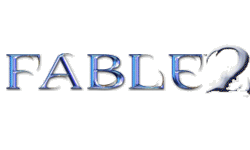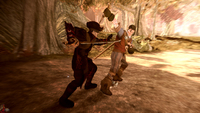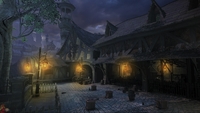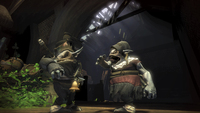|
|

|
PLATFORM
|
Xbox 360
|
BATTLE SYSTEM
|

|
INTERACTION
|

|
ORIGINALITY
|

|
STORY
|

|
MUSIC & SOUND
|

|
VISUALS
|

|
CHALLENGE
|
Very Easy
|
COMPLETION TIME
|
Less than 20 Hours
|
|
OVERALL

|
+ The GTA of RPGs
+ Extremely sharp controls
+ Huge, colorful, and interesting world
+ Children and the dog provide real emotional ties to Albion
- Many technical and gameplay bugs
- Short
|
Click here for scoring definitions
|
|
|
What motivates a hero to do great things? A desire to do good? A lust for power? Revenge? It's a question you'll have to ask yourself as you adventure in Fable 2, the sequel to Peter Molyneux and Lionhead's acclaimed, if somewhat overhyped, Xbox role-playing game. Fable 2's Albion is a world tailor-made for adventurers, with danger lurking around every corner, villains hidden in the shadows, and corruption eating away at a decaying society. As one of the last heroes left, you can help save it, or possibly hasten its descent into decadence. Like its predecessor, morality and choices play a major role in shaping Albion's future, and your own.
Fable 2 once again begins in the player's childhood. As Sparrow, a mischievious boy or girl in the slums of Old Bowerstone, the player is led through a series of quests designed to teach the basics of the game. However, the events of this time period are no mere tutorial, as Sparrow's actions in his youth will have a significant effect on Old Bowerstone in the future. As this tutorial level draws to a close, events are set into motion that will change Albion forever, unless Sparrow can find a way to stop it. Like the original, the events of Fable 2 span decades, although thankfully players won't find themselves sixty years old at the game's conclusion.
The plot of Fable 2 is extremely minimalistic and irritatingly cliché at times, but it really isn't there for any other reason than to provide motivation for Sparrow, and it actually does a very good job of this. The real story, however, can be found all over the world. While Fable's Albion was a medieval world of knights and dragons, Fable 2's Albion has evolved to more closely resemble late 18th, early 19th century Britain, towards the beginning of the industrial revolution. There is a certain degeneracy prevailing throughout the world, but it affects different cities in different ways. Bowerstone is home to the middle class; the streets are crowded, the people are rude, and the buildings are packed together with mere inches between them. Oakfield, in contrast, is a sprawling, open farming village with friendly, although timid, people. Bloodstone stands in stark contrast to both, almost ripped straight out of Pirates of the Carribean; a lawless city filled with pirates, hookers, and thugs.
While the main adventure can be completed in mere hours, doing so would defeat the entire purpose of the game. Fable 2 is basically what would happen if Rockstar set out to make an RPG. It's a sandbox game with dozens of distractions that can keep a player away from the main quest for hours at a time. There are dozens of sidequests with various rewards, simple jobs to earn money, nooks and crannies throughout the world to discover, and even relationships and families to form. All these elements help bring Fable 2 to life and turn it into an enjoyable, memorable, and addictive experience.
 S is for Sparrow!
S is for Sparrow!
|
|
Of all the new bits of gameplay provided in Fable 2, probably the most significant is the ability to form a family. While Fable allowed the player to find a wife, Fable 2 goes a step further, allowing the player to have children. In the early stages of the game these children are merely infants in a crib, but as the game progresses, they grow up, becoming adorable little rapscallions, enthusiastically greeting their heroic parent every time he returns home. Interestingly, the hero's children naturally take after their parent; if the player's hero is evil, so too will be the child. While Peter Molyneux is known to overstate things, this is one thing he got very right. The early stages of family development could use a bit of work, as the player can basically pick a random girl off the street to marry and it won't really affect things one way or another, but the addition of children really adds a lot to the game. The player isn't likely to feel any real attachment to his spouse during the course of the game since no relationship ever really develops, but the bright, smiling faces of one's children makes leaving home difficult every time.
The other major new aspect of the game, and one that received a lot of media buzz, is the player's faithful canine companion. While it doesn't quite live up to everything Molyneux promised (there is still a HUD, for example), it is nonetheless an important part of the game and merged extremely well with the rest of the gameplay. In fact, in all likelihood the player will care more about his dog than about his own spouse. The dog's purpose in the game, aside from providing a constant emotional bond to the world, is surprisingly diverse. The dog is able to sniff out treasure, both buried and in chests, and is even essential to some quests, leading you across an area in search of a hidden target. In combat, the dog will sometimes pounce on fallen enemies, finishing them off while the player focuses on more immediate threats. Sparrow's furry companion, interestingly, is probably the most well-developed character in the entire game. The dog joins the player during childhood and stays with him constantly. At one stage in the game, after being away for a lengthy amount of time, the dog is the first to greet the hero upon his return. At all times, the dog looks and acts exactly as one would expect a dog to. He whimpers and cowers when he's scared, jumps and barks when he's excited, and even limps and nurses his paw if he gets hurt.
Further enhancements have been made to nearly every aspect of the original game. Gifts can be given to virtually anyone, if they're willing to accept them, and once a character likes Sparrow enough, they might even give him a gift. There are more expressions than ever before, and some can even be extended, providing more powerful, or potentially disastrous, results. Most impressively, virtually every building in all of Albion is for sale, and if it's not for sale, the chances are a simple quest is all that's needed to make it available. Owning property is probably the most lucrative form of cash-flow in the game, as owning stores and renting homes provides gold constantly at five minute intervals. Unlike most RPGs, defeating enemies doesn't reward the player with monetary gains, so finding ways to earn large sums of cash is quite important.
 Night falls over Bowerstone.
Night falls over Bowerstone.
|
|
The morality system of Fable has also seen some improvements, most notably in an additional form of moral choice. In the original game, sliding further towards good or evil would cause the player's appearance to change, gaining a halo or devil horns. In Fable 2, a second slider has been added, determining the player's corruption or purity. A corrupt character indulges in the seedier pleasures of Albion, while a pure character keeps his body wholesome. The different sliders affect the hero's appearance in different ways, which can result in a more human or more demonic or angelic persona. The practical upshot of this is that the player has more control over his appearance than in Fable. Morality points are also handed out in a much more balanced way this time around. Defeating aggressive enemies no longer grants colossal amounts of good points, so players won't find themselves needing to go on killing sprees to keep it in check. The drawback to this, unfortunately, is that there's really no easy way to absolve oneself of evil deeds. A killing spree can still make a player impressively evil, but good points are much less common.
Combat has also changed a lot, mostly for the better. Although the combat is not actually (and thankfully) one-button, the controls are extremely sharp and easy to learn, and the combat is fast and fun as a result. Like Fable, there are three different forms of combat: strength, skill, and will, and each of these is associated with a different face button on the Xbox 360 controller. Melee combat is controlled by the X button, ranged combat by the Y button, and will combat by the B button. The A button is used for sprinting, performing dodge rolls, and as a general "ok" button. Defeating enemies is rewarded with experience, but unlike most games, different types of experience are awarded depending on what type of attack was used, and these experience points can be spent to improve their associated skills.
Melee combat begins with simple combo attacks, but eventually the ability to block and perform powerful flourish attacks can be acquired. Ranged combat, likewise, begins with simple fire-from-the-hip tactics, but eventually the ability to aim, zoom, and even target individual body parts, can be acquired. Will combat consists of a wide variety of spells, and the player can quickly activate a weak spell by tapping the B button, or charge higher level spells by holding the B button for extended lengths of time. Even though all four face buttons are used during combat, binding each form to a single button works extremely well, and the different styles mix together fluidly during combat. With each form, the basics are extremely easy to use, but the more powerful abilities take a fair bit of skill to master. This is particularly true of ranged combat, which is probably the most enjoyable of the three.
The biggest downside of combat is simply the lack of weapons, and this was an issue in Fable as well. While the weapon choices have noticably improved, particularly in the ranged variety, they are still quite limited. Specifically, there are only four different qualities of any given weapon, and since most players will probably find a weapon type they like and stick with it, this essentially limits the game to four weapons per character. Some weapons can be enhanced by special stones known as augments, but this really changes little, as even these are limited in variety. Ranged weapons have a bit more diversity, as there are now three different types of weapons, and of them, a few different sub-types. Pistols and rifles come in flintlock, turret, and clockwork varieties, which affect how many bullets they hold and how they are reloaded, while crossbows can be light, heavy, or repeating. There is also a blunderbuss weapon, which is essentially a shotgun for use at close range.
 I don't think these are what Calvin imagined.
I don't think these are what Calvin imagined.
|
|
Fable 2's visual style is extremely stylized, much like its predecessor. Heads, feet, and hands, in particular, are exaggerated, and the entire world has a fairly cartoonish quality to it. However, Fable 2 is notably darker than the original game, thanks in part to its new setting. There is an almost Burton-esque quality to much of the art design that helps give the game a fairly creepy atmosphere a lot of the time. All the models are extremely crisp and the animation is smooth.
The audio is of likewise quality. The voice acting is excellent, although the voice snippets of villagers are fairly limited in number, and can grow irritating late in the game once they've all been heard dozens of times over — and believe me, the villagers love to talk. The soundtrack is also excellent, although mostly subdued. The main theme is excellent and quite memorable, but most musical pieces serve only as background atmosphere, and do the job wonderfully.
While most of this review has been quite positive thus far, it's important to realize that Fable 2 is far from a perfect game. Most of its faults, however, are of a technical nature. There are numerous visual and audio bugs, such as the dog becoming semi-transparent or characters suddenly going silent when they should be talking. There are numerous other minor bugs throughout the game. Fable 2 also sports extremely long load times, although thankfully they don't usually interrupt the flow of the game. There is also a noticable lag when opening a menu or shop, and most of the menus in the game are frustrating to navigate. None of these issues, however, are gamebreaking, and for the most part they're minor irritations when compared with how enjoyable Fable 2 is to play.
Although it's clear that Fable 2 isn't everything Peter Molyneux claimed it to be, the golden rule with Molyneux games is simply to ignore anything he says about them, and keeping that in mind, Fable 2 is an excellent game and a huge step above the majority of the competition. It's easily one of, if not the best RPG currently available on the Xbox 360, and that's saying a lot. Although the story quest is short and fairly trivial, the enormous and colorful world can keep a player entertained for thirty hours or more. The original Fable was a game that many RPGamers missed out on due to the significant lack of other RPGs on the Xbox. The situation has changed, and Fable 2 is definitely a game that shouldn't be missed.
Review Archives
|









